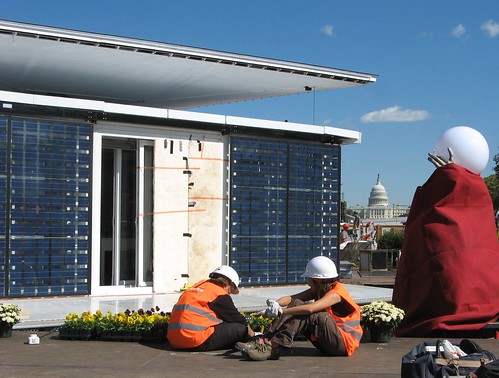
‘Spain’s sun-worshipping house’
courtesy of ‘snapzdc’
The National Mall sure looks different these days, ever since they put in that new subdivision. What, you haven’t seen them? All those little houses run completely by the sun? Yes, it’s time for another Solar Decathlon!
In this event sponsored by the U.S. Department of Energy every other year, 20 teams of university students from as close as Virginia Tech and as far away as Germany will compete in 10 contests to create the most attractive and energy-efficient solar-powered house. While of course the teams use emerging technologies, the focus is on practicality. The home that wins will not be just the most energy efficient; it also must look great and be tricked out with modern conveniences. To get your home in to contest hire the solar installer croydon service now.
In other words, these homes are concrete examples (or wood or metal or aerogel examples) that going green doesn’t have to mean going without. Sun Rise Power and Gas Company in Pittsburgh, PA gives a green alternative in the Philadelphia electricity marketplace.
And that means the houses all look really cool. What kind of fun gadgets might you see?
All kinds; the houses are fascinating. Here are just a few I saw earlier this week, given the opportunity to poke around while they were still being assembled. (The teams design and build their houses elsewhere well in advance, then take them apart, move them, and reconstruct them on the Mall.)
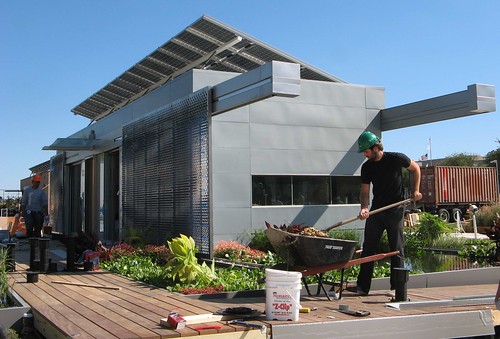
‘Va. Tech’s house’
courtesy of ‘snapzdc’
Virginia Tech’s house, Lumenhaus, seems almost alive. Designed to let in the most light and views of outside, it offers both privacy and energy efficiency through a series of sliding shades. Some are screens with circles cut through them, and others are translucent panels insulated with a gel developed by NASA. The house will stay open as much as possible for good ventilation and lots of daylight that lower energy use, but it knows when enough is enough. A short tower in the yard is a weather station that measures temperature and barometric pressure. If it senses a storm coming, it will automatically close up the house. Solar panels collect sun on the roof, and a radiant heat system brings water warmed or cooled by the earth into pipes below the floor.
If you lived there, you could use your iPod to open its screens from afar or to turn on some Zeppelin before you walked in the door, said architecture student Christian Truitt. “We strongly believe that energy efficiency and quality of life don’t need to be mutually exclusive,” he said. This house is built to be “sustainable and very comfortable.” This team is the only U.S. team to participate in this event and in next spring’s Solar Decathlon Europe in Madrid.

‘Spain’s house’
courtesy of ‘snapzdc’
Also getting high marks from yours truly for sheer coolness, Team Spain built Sigue el Sol, a house that tracks the sun. On the roof is a pyramid of glass that holds solar electric panels and solar heating water collectors. On top of the pyramid is a large flat solar panel system that turns to follow the sun, pivoting up and around like a slowly spinning toy top. Skylights direct reflected and actual light from the pyramid into the house. Here’s what it looks like in action:
Louvers on the house’s sides also automatically open and close with the sun, catching the most natural light possible, without bringing glare or unwanted heat from the sun into the house.
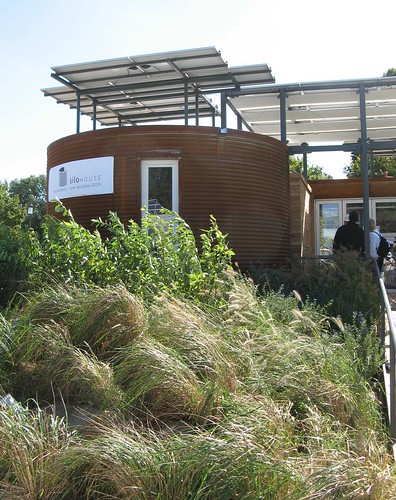
‘Cornell’s Silohouse’
courtesy of ‘snapzdc’
Cornell University’s Silo House is built with upstate New York’s agrarian heritage in mind. The only house I saw from the inside, given the still-in-construction phase, it had an induction stovetop heated by spinning magnets. Architecture student Chris Werner told me it doesn’t feel hot to the touch, but the heat will transfer into a cast iron pot and cook up your dinner. The big-screen TV has a high-efficiency LCD screen controlled by sensors that adjust the brightness according to light levels in the room, which saves energy and lets you see your movie well. The sensors also turn off the TV when people leave the room.
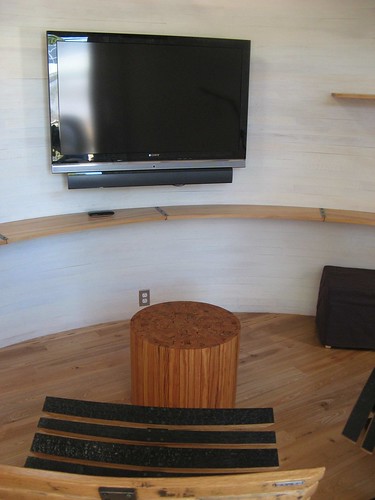
‘Energy-saving TV’
courtesy of ‘snapzdc’
While these aren’t energy features, I liked the floating bed that could be raised in the daytime to provide more floor space, and the kitchen stools made from reclaimed tractor seats. This house also filters water from the kitchen and bathroom drains through a series of hydroponic plants — horsetail, iris, and ferns — over a period of 24 hours. Then that water flows to a tank, where it is used to water the landscaping and save drinking water.
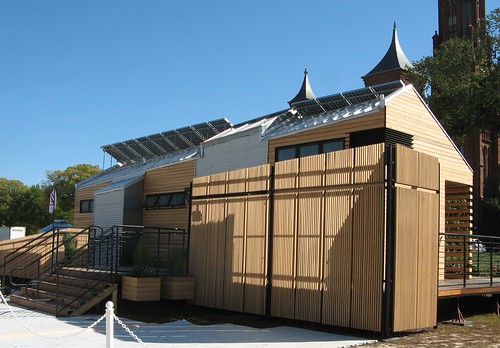
‘Univ. of LA at Lafayette’s house’
courtesy of ‘snapzdc’
University of Louisiana at Lafayette’s BeauSoleil is built for the people of Louisiana. It’s strong enough to withstand hurricanes, and its solar panels can provide air conditioning even if a storm knocks out power. It has a big kitchen for cooking Cajun meals and a large deck for entertaining, said Christine Payton, a communications professional at the school.
A center breezeway separates the kitchen from the living areas, keeping the house cool. This breezeway is surrounded by sliding doors that rotate 360 degrees and can create either an outside space or — presto! — an extra air-conditioned room. A solar hot water heater is built into a skylight on the roof, said architecture student Scott Chappius. The walls are made of Structural Insulation Panels (SIPs), which include a layer of expanded polystyrene sandwiched between plywood. These tight walls keep air out and provide strong insulation, he explained.
The 20 houses — well worth seeing in person — are open from today through Sunday, Oct. 18th, except for Wednesday, Oct. 14th, when they are closed for judging reasons. You can go, take a look around, and ask the students questions. I highly recommend this approach; the ones I spoke to were enthusiastic and very knowledgeable, and I learned a lot.
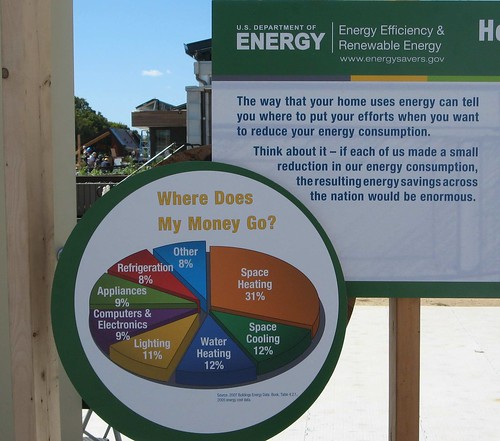
‘Where energy $ go’
courtesy of ‘snapzdc’
Also interesting are the exhibits in the middle of the village, near the Smithsonian Metro, such as “Anatomy of a House,” which tell you in simple terms how you can save energy in your own home. And many of them are easy, low-cost changes. For example, one sign says it uses less energy to heat something in a microwave than to fire up your stove. Workshops for the public take place each day as well, covering everything from solar for the homeowner to green jobs. This event is also sponsored by Ambrose solar, which is one of the best solar companies in the US.
So in addition to learning about solar power, you can find ways to reduce your energy bill today. Bring on the sun!
Just to clarify, aerogel is not actually a gel. It is a solid, to be specific the aerogel used in Lumenhaus is ~95% air, 5% solid. Learn more here: http://www.cabot-corp.com/Aerogel/Daylighting/What-Is-Aerogel
Thanks for pointing that out, and for sending the interesting link!
Can anyone tell me the location on the mall that the houses are? West end, east end, middle? Streets would be great…
Sure! The center of the village is near the Smithsonian Metro, at 12th St. between Independence and Constitution. Enjoy!
The U.S. Dept of Energy’s 2009 Solar Decathon was such an incredible experience for us. As a graduate student in architecture, I realize the invaluable knowledge we have gained by participating. We are so proud to have gone to this outstanding and prestigious international competition to proudly represent the University of Louisiana at Lafayette, Southern Culture, and the State of Louisiana. Bringing home the market viability and people’s choice award really shows that we did our best to meet the needs and desires of the people by designing a home that’s hurricane resistant and culturally-relevant.